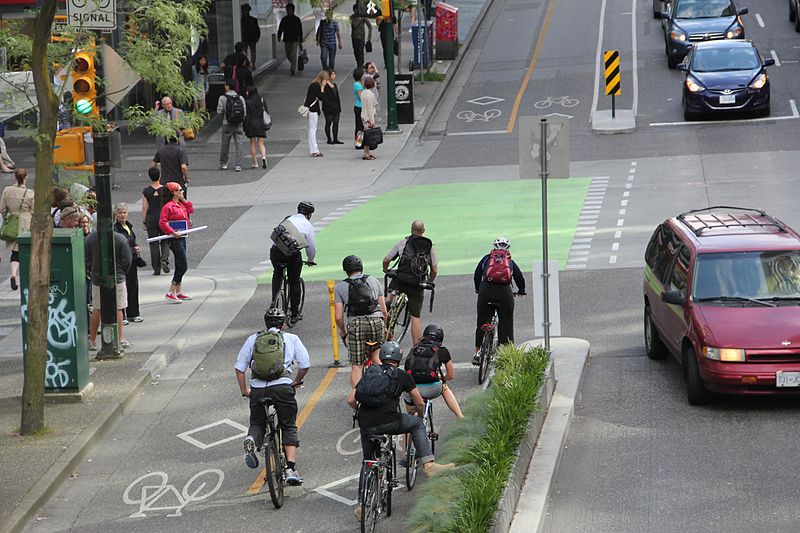In addition to lots of twitter arguments about the Green New Deal, my feed has also been full of arguments about the relative role for electric cars.
I get the appeal of electric cars: it’s hard to envision any scenario where we address climate change without relying on electrification of our vehicle fleet. It’s a technology that has lots of promise. These cars appeal to our desires for innovation, yet still recall previous moments of national pride.
All that said, the simple math on emissions remains clear: electric cars alone won’t solve our surface transportation GHG problems. We have to drive less.
A number of articles in recent months have tried to emphasize this point, but they don’t often seem to break through. I’d like to highlight this one from Meredith Hankins:
…when we’re all driving zero-emission vehicles that plug into a zero-carbon grid, our transportation emissions will indeed be extremely low carbon. But here’s the thing: that future is a long way off. California’s ZEV mandate calls for only about 8% of new vehicle purchases to be ZEVs by 2025–and that’s just new vehicles. The average car sold today will be on the road for at least 11 years, locking in a decade plus of GHG emissions for every non-ZEV sold. In addition to our long-term electrification plans, we have to focus on strategies to reduce emissions from those non-ZEVs in the near term by getting them off the road.
The basic facts about cars (regardless of their power source) haven’t changed. They’re remarkably large and inefficient vehicles. They take up large spaces and require lots of energy to move.
Since the ultimate goal here is to reduce GHG emissions, making transport more energy-efficient in total is an important intermediate objective, we need to not just shift the energy sources to electricity, but also consider the overall efficiency.
Limiting automotive GHG emissions isn’t simply about making cars cleaner, but also about limiting how much we use these inefficient modes of transport. In other words, driving less.
Don’t take my word for it, just listen to the IPCC. Here’s Meredith Hankins again:
But here’s the thing: we can’t afford to ignore significant climate mitigation measures just because they are politically difficult.
(emphasis added)
The IPCC’s recent bombshell report notes that “demand-side mitigation and behavioural changes” are going to be needed to avoid the worst climate change impacts. Transportation mitigation pathways for limiting global warming to less than 1.5 degrees require not just “[t]echnology-focused measures,” but also strategies based on “[s]tructural changes that avoid or shift transport activity” that have “received lesser attention in most global transport decarbonisation pathways up to now.”
To make things a bit more tangible, here are the kinds of targets California thinks they need to hit:
- Quadruple the proportion of trips taken by foot by 2030 (from a baseline of the 2010–2012 California Household Travel Survey).
- Strive for a nine-fold increase in the proportion of trips taken by bicycle by 2030 (from a baseline of the 2010–2012 California Household Travel Survey).
Dramatically increasing bike and walk trips (and doing so immediately) is both a simple goal, yet a radical one. It’s a radical change from the status quo, but also something simple enough to do. Meeting these goals doesn’t require any technological miracles (or even any new technology at all).
Breaking it down a bit further, hitting those targets realistically requires policies that impact both the supply of places that support bike and walk trips, as well as policies that increase demand for them.
On the supply-side, hitting these targets means increasing the supply of places suitable for bike and pedestrian trips: safe bike and pedestrian infrastructure, expanded at a massive scale. These are proven and relatively simple tasks, but the scale called for here is still daunting. Ask anyone who’s worked on these projects about the effort required to build 9x as many protected bike lanes.
Additionally, all of these supply-side elements are things local governments can do. For all of the Mayors out there talking a good game on climate, here’s the biggest bang for your buck. Furthermore, places that are already walkable and bikeable will be far better suited to accommodate shifting behavior. It’s entirely plausible to picture a nine-fold increase in biking in a big city.
The demand side perhaps more important in shifting behavior, particularly for pricing incentives (against cars, for walking/biking/transit). Some of this can happen at the local level (parking policy, pricing) while others will require state-level and national action. Just look back at the increases in transit usage when gas prices go up.











